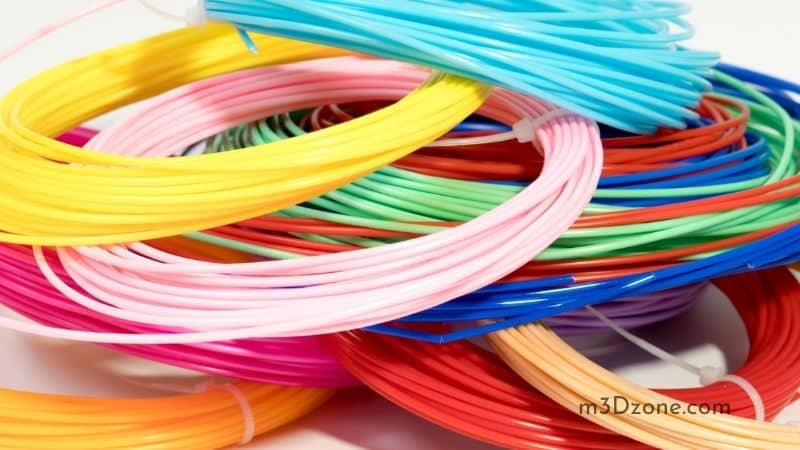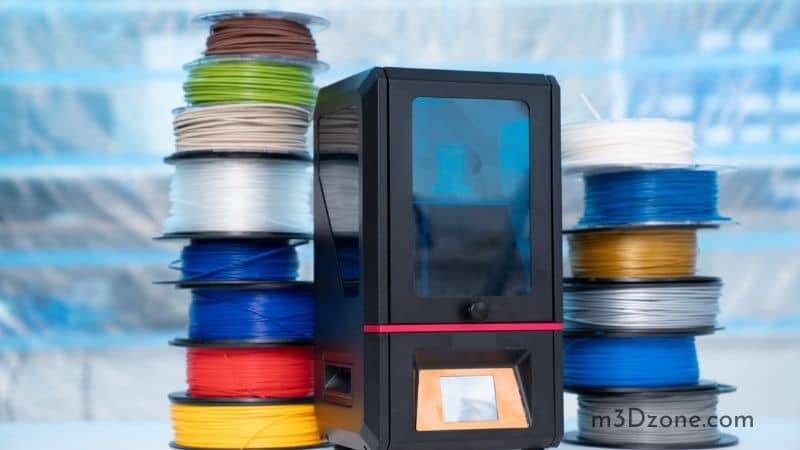
Not all 3D printer filaments meet safety standards for use in a dishwasher. A 3D printer filament’s suitability for dishwasher use depends on its glass transition temperature. This is the temperature range where a printer material turns from solid to soft without necessarily melting.
Quick Navigation
- Is the PLA Filament Dishwasher Safe?
- How Do You Disinfect a PLA Filament?
- Can You Wash PLA Plastic?
- Is a 3D Printer Filament Toxic?
- Is 3D Printing Filament Dishwasher & Microwave Safe? PLA vs. ABS
- Is a 3D-printed PLA Dishwasher Safe?
- Is a 3D-printed ABS Dishwasher Safe?
- Is a 3D-printed PETG Dishwasher Safe?
- Conclusion
Most dishwashers run at household water heater temperatures, although some control the heat internally. Standard household water temperatures range between 55 and 75 degrees Celsius. This renders the PLA filament unsafe for the 3D dishwasher.
PLA has a lower glass transition temperature range of 57-70 degrees Celsius. This renders it unsafe to place in the dishwasher. But other 3D printer filaments such as ABS and PETG fit the bill. However, you’ll need to comply with their food-safe epoxy.
Any new technology raises questions that need answers to clear doubts and concerns about its use. The 3D printer filament dishwasher is not an exception.
Most users’ concerns hinge around the safety of filaments used in the 3D printer dishwasher.
Follow this comprehensive article and guide to the end for more information on the same.
Is the PLA Filament Dishwasher Safe?
PLA is a fairly safe and biodegradable plant material. It’s used in 3D printing and manufacturing processes. Additives and dyes of unknown nature that manufacturers use and may not disclose are the only safety concerns to note.

However, a standard 3D printer dishwasher works in a household water heater temperature that ranges between 55 and 75 degrees celsius is making PLA filament unsafe for its use. Although a safe 3D printing material, PLA works at the glass transition temperatures of 57-70 degrees Celsius. Such temperatures don’t suit the dishwasher.
Warm water deforms your 3D printed objects. If placed in a dishwasher with a temperature of 60 degrees Celsius, your object will deform like ice cream. Suppose the temperature continues to rise, at 80-100 degrees Celsius, the object will melt.
How Do You Disinfect a PLA Filament?
Most FDM printed parts and models are PLA. It remains so because there aren’t many alternatives that you can disinfect using high temperatures without causing damage to the printed object.
3D printing forms hollow crevices in which bacteria and viruses can hide. So, no matter how food-safe your 3D print looks, you still face this challenge.
Hospitals use high temperatures to sterilize things which is one way of disinfecting the 3D printer filament objects. Unfortunately, you can’t use sterilization on PLA filament models unless you want to reshape or even damage them because they can’t withstand the high temperatures witnessed during sterilization.
Unless you subject your PLA filament kitchen utensils to annealing, then don’t sterilize them. Annealing is the process of increasing temperatures to improve an item’s firmness, tensile strength, and heat resilience. It helps improve the PLA characteristics.
Ethylene Oxide (EtO)
Ethylene oxide applies mostly to the sterilization of medical and pharmaceutical products that can’t withstand the high-temperature conventional steam sterilization.
EtO gas infiltrates products to kill the microorganisms that remain after the printing process or during production and packaging stages that cause bacteria buildup.
An air-EtO gas mixture in the ratio of 97:3 effectively cleans 3D-printed objects. Toxic chemicals or particles pose a great danger to food safety. As such, 3D-printed food utensils need occasional cleaning.
Can You Wash PLA Plastic?
If you wash a 3D-printed object in hot water or use a dishwasher, the object may deform or warp. PLA, being brittle, runs the risk of cracking into little pieces and may damage the dishwasher altogether.
Advisably, you need to avoid washing PLA plastic or any PLA 3D-printed parts. PLA is biodegradable and vulnerable to sunlight and moisture.
You may want to clean the desktop printers of your 3D printing filaments, but you need to avoid using water. PLA, being a bioplastic material derived from plants like rice, potato, and corn, absorbs a lot of water from the environment to decompose.
In the 3D printing industry, moisture-damaged PLA filaments cause problems with 3D prints and can easily damage printers as it swells.
Alternatively, to mitigate moisture and its consequent impact on 3D printed models, you may need to waterproof the objects.
Waterproof PLA Objects
The 3D printing community thrives through continuous innovation in 3D printing technology.
After printing PLA items for your aquarium, you may need to make them waterproof to ensure it last longer. As a food-grade filament, you know you need not wash it using hot water or let it come into contact with water unless it’s fully waterproofed using wax or a fixative spray.
Alternatively, avoid using a dishwasher to wash your 3D prints. Instead, use lukewarm water and a mild anti-bacterial detergent immediately after use. This way, you remove any surface bacteria and significantly reduce the risk of melted prints.
Related: PLA vs. PETG
Is a 3D Printer Filament Toxic?
The innovative mind-frame continues to drive the Illinois Institute of Technology into making significant findings in 3Dprinting technology, giving it a worldwide status. None is more profound than the finding that 3D printer filaments indeed emit toxic fumes that may cause serious health concerns.
3D printers work by melting plastic filaments and materials such as nanoparticles, metals, and thermoplastics. They then stack the materials layer by layer to form the 3D model. In the process, plastic filaments burn out, emitting toxic gas fumes into the environment.
Research shows that both the ABS and PLA particles emit dangerous and toxic fumes that negatively impact cell viability, with ABS producing a more potent emission.
To mitigate the effect of toxic emissions from both the PLA and ABS filaments, you are advised to buy an enclosure for your 3D printers or invest in an air purifier system that cleans the air at the printing space.
Is 3D Printing Filament Dishwasher & Microwave Safe? PLA vs. ABS
-
PLA Filament
PLA filament items may not be suitable for a dishwasher. They tend to warp and become hugely distorted. Consequently, as a filament, it soon becomes waterlogged, rendering it unfit for printing.
Items made of PLA tend to warp in warm water but can be washed by hand in cold water.
PLA filaments aren’t microwave-safe since they can’t withstand the high temperatures associated with the microwave.
Other people discourage the use of PLA in the microwave for food as it picks bacteria through layer lines and micropores.
-
ABS Filaments
On the other hand, ABS proves suitable for use in the dishwasher. It’s heat-resistant, enabling people to use it safely in dishwashers. ABS filaments thrive in dishwasher conditions such as high temperatures, organic solvents, and alkaline salts.
3D printing news intimates that you can use a dishwasher to wash an ABS-printed coffee cup. ABS has a strong and rigid plastic superior in hardness and toughness, making it dishwasher-safe.
It may not be recommended for use in the microwave because of its toxic nature as an oil-based plastic filament that is not food-safe.
Is a 3D-printed PLA Dishwasher Safe?
PLA isn’t a dishwasher-safe filament due to its low heat resistance levels. A standard dishwasher’s temperature can go up to 60 degrees Celsius, the same temperature at which PLA starts to soften. This can lead to the deformation and warping of 3D prints.
In mitigation, heat resistance is significantly improved using the annealing process. Otherwise, PLA remains unsafe for use in dishwashers due to its sensitivity to heat.
Is a 3D-printed ABS Dishwasher Safe?
Most people use ABS safely in dishwashers as it’s heat-resistant. Its glass transition temperature is 105 degrees Celsius. As such, it comfortably meets dishwasher conditions. The temperature required for its degradation is higher than that in the dishwasher. This makes it an excellent filament for this purpose.
Is a 3D-printed PETG Dishwasher Safe?
PETG is fairly heat-resistant, making it suitable for use in the dishwasher. However, it barely surpasses the standard household temperatures. Its glass transition temperature is 75 degrees Celsius. Nevertheless, it can withstand most households’ temperatures.
Unfortunately, PETG contains glycol modifiers that prevent it from crystallization. Yet it needs to crystallize to improve heat resistance.
Conclusion
Well, that’s it about 3D printer filaments and whether they can be used in dishwashers. Notably, ABS and other filaments like PETG may be safe to use in 3D-printed dishwashers. This is because they’re heat-resistant.
On the other hand, PLA can’t withstand the standard household temperature. This makes it unsafe for dishwasher use.
Recommended Reading
How Long Do 3D Printed Houses Last?
How long do 3D printed houses last? their longevity entirely depends on a few factors, such as the raw materials used, type of printer, and quality.
Is ABS Food Safe? Things You Need to Know!
Is ABS food safe? "It is important to note that ABS is generally considered food safe," according to the U.S. Food & Drug Administration. Let's see!
Types of 3D Modeling. What’s the Best for You?
Different types of 3D modeling techniques are meant to create photorealistic digital objects and outcomes. It all comes down to designers and their skill set.
